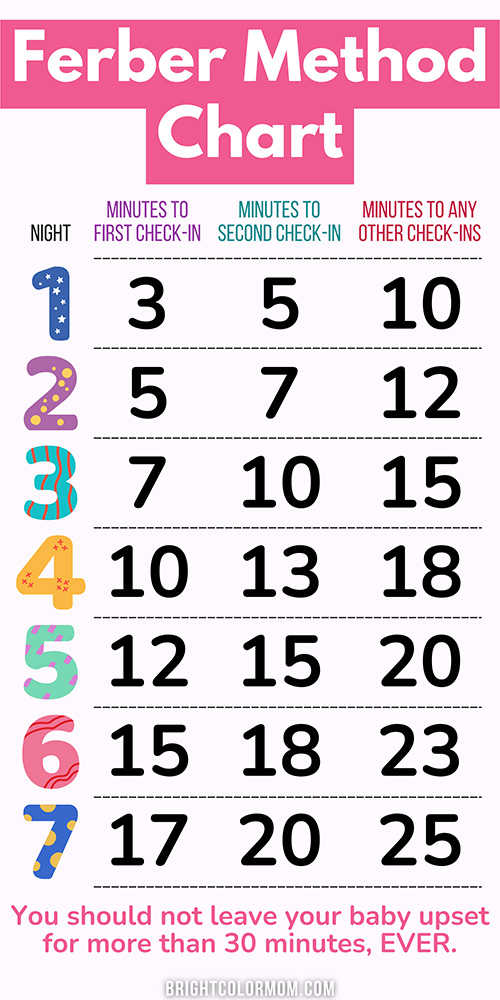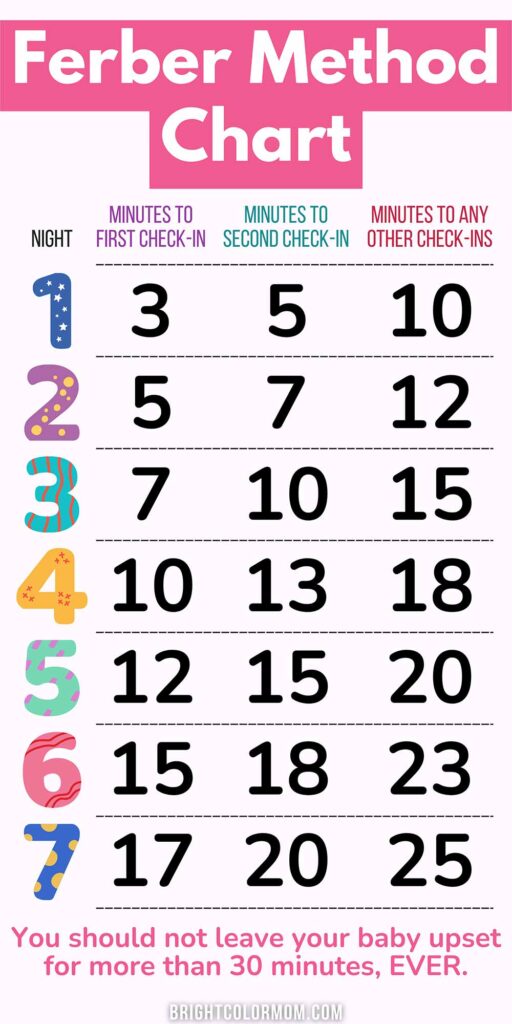New parenthood is a beautiful whirlwind. But let’s be honest, that whirlwind can leave you feeling like a sleep-deprived zombie by nightfall. Let me guess: you spend an eternity rocking your little one to dreamland, only to have them erupt in a bloodcurdling scream the moment you put them down. Yeah, been there, done that. If you’re ready to reclaim your nights and get your baby on the path to independent sleep, then the Ferber method might be your sleep-saving BFF.
The Ferber method is a sleep training technique that helps your baby learn to fall asleep and stay asleep on their own. It’s not about letting your baby cry for hours on end (we’re not monsters!), but rather a gradual approach that involves check-ins to offer reassurance. Think of it as teaching your baby a valuable life skill: the art of self-soothing.
This method works best for babies between 4-6 months old who are already healthy eaters and gaining weight well. It’s also a great option for little ones struggling with night waking or difficulty falling asleep independently. However, it’s not a magic bullet (sorry!). If you’re co-sleeping hardcore or your parenting style leans super attachment-oriented, the Ferber method might not be the best fit. But other sleep training techniques are out there – and I’ll touch on those, too.
For now, let’s dive into the Ferber method and get you that glorious sleep you deserve!
Benefits of the Ferber Method
The Ferber method isn’t some sleep-deprivation torture chamber – it’s actually a strategy with some pretty awesome benefits for both you and your little one. Here’s why this method might just be your new favorite thing (besides that adorable baby smile, of course).
Sweet Dreams for Everyone
Sleep deprivation is no fun for anyone. The Ferber method helps your baby learn to fall asleep independently and stay asleep longer, which translates to more sleep for you too. Imagine waking up feeling refreshed and ready to tackle the day!
The Art of Self-Soothing
One of the coolest things about the Ferber method is that it teaches your baby valuable self-soothing skills. Think of it as equipping them with the tools they need to drift off to dreamland on their own, without needing you to rock them for hours. This skill will come in handy throughout their lives, not just during those early sleep struggles.
Independent Sleeper
By learning to fall asleep on their own, your baby is setting themselves up for success when it comes to independent sleep. No more relying on rocking, feeding, or other sleep associations that can become disruptive over time. The Ferber method promotes healthy sleep habits that will stick with your little one as they grow.
Step-by-Step Guide to the Ferber Method
Now that you’re sold on the amazing benefits of the Ferber method, let’s get into the nitty-gritty of how it actually works.
1. The Bedtime Routine
Just like adults, babies thrive on routine. Before diving into the sleep training itself, establish a calming and consistent bedtime routine. This might include a warm bath, a gentle massage, a book, and a lullaby. This routine signals to your baby that it’s time to wind down and prepare for sleep.
2. The Drowsy But Awake Sweet Spot
Once the routine is complete, it’s time for the main event: putting your baby down to sleep. Here’s the key – aim for “drowsy but awake.” This means your baby is showing sleep cues (yawning, eye rubbing) but not completely knocked out. Placing them down awake helps them learn to connect sleep with the crib, not with rocking or feeding.
3. Check-Ins with Increasing Intervals
Here comes the part that sounds scary: the check-ins. Don’t worry, you won’t abandon your little one to cry for hours! The Ferber method uses a system of graduated check-ins. This means you’ll go in to soothe your baby at specific intervals that gradually increase throughout the night.
For example, on the first night, you might check in after 3 minutes of crying, then 5 minutes, and then 10 minutes. The key is to be consistent with these intervals and offer calming reassurance without picking your baby up. Your actions should include soothing words, gentle pats, and letting them know you’re there, but it’s time for sleep.
I’ll get into a sample schedule with specific check-in times in a minute, but consistency is key! Sticking to the plan, even through some tears (it’s okay, they’ll be okay!), is what helps your baby learn this new skill.
4. Addressing Setbacks
Let’s be real, there might be a few bumps along the road. Your baby might cry harder on some nights, or they might have a growth spurt that throws things off. Don’t despair! Stick to the plan and remember, it might take a few nights (3-5 on average) for your baby to fully adjust.
Sample Schedule with Check-Ins
Now that you understand the concept of graduated check-ins, let’s look at a sample schedule to give you a clearer picture. This is just a guide and you might need to adjust the intervals slightly based on your baby’s temperament. I don’t recommend EVER letting a baby be upset longer than 30 minutes.

| Night | Check-In 1 | Check-In 2 | All Others |
| 1 | 3 minutes | 5 minutes | 10 minutes |
| 2 | 5 minutes | 7 minutes | 12 minutes |
| 3 | 7 minutes | 10 minutes | 15 minutes |
| 4 | 10 minutes | 13 minutes | 18 minutes |
| 5 | 12 minutes | 15 minutes | 20 minutes |
| 6 | 15 minutes | 18 minutes | 23 minutes |
| 7 | 17 minutes | 20 minutes | 25 minutes |
How to Implement This Schedule
On the first night, after your calming bedtime routine, place your drowsy but awake baby in the crib. If they start to cry, wait 3 minutes before going in to offer reassurance. Keep it short and sweet – and try not to pick them up.
Wait for another interval (5 minutes) before checking in again. The next time, wait 10 minutes. After the third check-in, you don’t have to increase the interval for that night, but don’t shorten it. Remember, you’re not picking your baby up – you’re simply letting them know you’re there without disrupting their chance to fall asleep independently.
This is just a sample, and you might need to adjust based on your and your baby’s needs. If your baby is crying excessively (think inconsolable for more than 20 minutes), take a break, pick them up to soothe them if needed, and try again when they’re calmer. Consistency is key, but so is responding to your baby’s individual needs.
By following this sample schedule and staying consistent with the check-ins, you’re setting your baby up for sleep training success. Remember, a few nights of tears can lead to weeks (and months!) of glorious sleep for you and your little one.
Pros and Cons of the Ferber Method
Are you excited about sleep training with the Ferber method, but maybe a little nervous about the whole “crying” thing? It’s normal! Let’s look at the pros and cons to help you decide if this method is right for you and your little one.
Pros
Sleep Training Success Stories
Here’s the good news: the Ferber method is effective for many babies! Studies show a significant improvement in sleep patterns for both babies and parents who use this method. Imagine waking up feeling refreshed and ready to tackle the day – that’s the dream, right?
Gentle Cry-It-Out
Compared to traditional cry-it-out methods where you leave your baby to cry for extended periods without check-ins, the Ferber method is a gentler approach. The graduated check-ins offer reassurance to your baby while still encouraging them to learn to self-soothe.
Building Self-Soothing Skills
One of the biggest benefits of the Ferber method is that it teaches your baby valuable self-soothing skills. This means they’ll learn to fall asleep independently and manage nighttime wakings without needing constant rocking or feeding. This skill will be their sleep superpower for years to come!
Cons
Tears
There will probably be some tears involved during sleep training. Hearing your baby cry can be emotionally challenging for parents (believe me, I get it!). However, it’s important to remember that these tears are temporary and part of the learning process. With consistency, the crying will decrease as your baby adjusts to the new routine.
Not a Magic Trick
The Ferber method might not work like a charm for every single baby. Some little ones might have a more stubborn temperament or underlying issues that require a different approach. It’s important to be flexible and open to other sleep training techniques if the Ferber method isn’t clicking.
Temperament Matters
Every baby is unique, and their temperament plays a big role in how well they respond to sleep training. If your baby is particularly sensitive or has high needs, the Ferber method might be too overwhelming initially. Consider your baby’s personality and adjust your approach accordingly.
Remember: Don’t feel like a failure if the Ferber method isn’t your happily ever after. There are other sleep training techniques out there and I’ll briefly explore some alternatives.
This post may contain affiliate links. If you make a purchase after clicking one, I may receive a small commission at no cost to you.
The Man Behind the Method
Let’s address a common question: who dreamed up this sleep-saving strategy? The mastermind behind the Ferber Method is Dr. Richard Ferber, a renowned pediatrician and the founding director of the Center for Pediatric Sleep Disorders at Children’s Hospital Boston.
Dr. Ferber published his groundbreaking book, Solve Your Child’s Sleep Problems, in 1985. This book introduced the Ferber Method as a more gentle alternative to traditional cry-it-out methods. Since then, the book has been revised and continues to be a valuable resource for parents struggling with infant sleep issues.
It’s interesting to note that Dr. Ferber himself has acknowledged that his method might be misunderstood at times. He emphasizes the importance of following the check-ins and responding to your baby’s cues, rather than simply letting them cry alone for extended periods.
So, there you have it! The Ferber Method is the brainchild of a sleep expert who aimed to create a more compassionate approach to sleep training.
Criticisms of the Ferber Method
The Ferber Method isn’t without its critics. Here are some common concerns parents might have.
The Cry Factor
Crying is a major sticking point for some parents. Attachment parenting philosophies often emphasize responding promptly to a baby’s cries for comfort and security. They might view the Ferber Method as too rigid and potentially damaging to the parent-child bond.
Ethical Considerations
Some parents and experts worry about the ethical implications of letting a baby cry for extended periods, even with check-ins. This study says crying causes no harm, though.
Societal Pressures
Let’s face it, there’s a ton of pressure on new parents to achieve “normal” sleep patterns for their babies quickly. This pressure can lead parents to feel like they “have to” try sleep training methods like the Ferber Method, even if it doesn’t feel right for their family.
Finding the Right Fit
Ultimately, the decision of whether or not to use the Ferber Method is a personal one. There’s no “one size fits all” approach to sleep training. Consider your baby’s temperament, your parenting style, and your comfort level.
Suppose your baby is high-needs or has already demonstrated a history of separation anxiety. In that case, you may want to use a different approach (or at least wait until they’re older to try the Ferber method). You might want to hold off on any sleep training if your baby just started teething, too.
Consulting a Pediatrician
Here’s a valuable resource to help you navigate this decision. This article discusses various sleep training methods, including the Ferber Method. It emphasizes the importance of talking to your pediatrician about the best approach for your situation. It’s worth reiterating that Dr. Ferber is, himself, a pediatrician! And other pediatricians agree that this method is both safe and effective.
Exploring Other Sleep Training Options
The Ferber Method is a powerful sleep training tool, but it’s not the only option in the toolbox. Here’s a quick peek at some alternative techniques.
- Pick-Up/Put-Down: This method involves picking up your crying baby, soothing them briefly, and then putting them back in the crib awake. Unlike the Ferber Method, there are no set intervals between check-ins.
- Chair Method: This gradual approach involves sitting in a chair next to your baby’s crib and gradually moving further away each night until you’re out of the room entirely.
Tailoring the Ferber Method
The beauty of the Ferber Method is its flexibility. Here are some ways you can modify it to suit your family’s needs.
- Adjust the Check-In Intervals: If the recommended intervals feel too long for your comfort level, start with slightly shorter check-ins and gradually increase them.
- Offer More Soothing Techniques: While the classic Ferber Method focuses on verbal reassurance and pats, you can experiment with shushing, singing, or rocking gently for a few seconds before placing your baby back down.
Experiment to find a modification that feels comfortable for you while still encouraging your baby to learn to self-soothe.
My Experience with the Ferber Method
As a new mom who started out vehemently against straight-up cry-it-out sleep training, I found myself searching for a solution when my daughter just would not sleep unless I held her. The Ferber method seemed like a reasonable compromise since I was “allowed” to comfort her when she cried. I quickly came to two realizations.
- My daughter would cry until she passed out, not because she’d found a way to soothe herself, and
- My heart could not bear to hear her cry. Whether I was in a different room or there with her, it hurt me physically.
Because of her unrelenting crying, we all got even less sleep than before. Even if I was sitting in a chair right next to her crib, she would continue to cry until I picked her up. As a result, it didn’t take long for me to abandon this method.
We kept trying different ideas, though. Eventually, a strategy of rocking her fully asleep before laying her down, using a white noise machine, and me sleeping in a bed in her room became our routine. After a couple of weeks, I could leave to go to my own bedroom while she continued sleeping. She now has zero gripes at bedtime, goes to sleep after I leave the room, and I can count on one hand the number of times she’s climbed into our bed to cosleep after a nightmare.
So the Ferber method was not suitable for my daughter OR me, but my attempt convinced me that it probably does work – if your baby is not as stubborn as mine! For the sake of fairness, don’t let my Ferber failure be your only deciding factor. This forum post is loaded with success stories – and many parents state that initial failures were due to a lack of consistency on their part.
FAQ
Is the Ferber Method safe for my baby?
Absolutely! When implemented correctly, the Ferber Method is a safe and effective way to teach your baby to sleep independently. There are no risks associated with the method itself, however, it’s important to remember that some crying is involved. As long as you’re following the check-ins and responding to your baby’s cues, you’re creating a safe and loving environment for them to learn this new skill.
How long until my baby sleeps through the night using this method?
Everyone’s little one is unique, but most babies see significant improvement within a few nights (3-5 on average) with the Ferber Method. However, it can take up to a couple of weeks for them to fully adjust and consistently sleep through the night. Consistency is key!
What if my baby never stops crying?
Hearing your baby cry is tough, but try to stay strong and follow the check-in intervals. It’s okay to peek in and offer soothing words or a gentle pat, but avoid picking them up unless there’s a true emergency (fever, vomiting, etc.). Remember, they’re learning to self-soothe, and picking them up might disrupt the progress.
Tips for Coping with the Crying
- Team Up: Having a supportive partner can help you stay strong during those tough nights. Take turns with check-ins so you can both get some rest.
- Distract Yourself: Focus on a calming activity during check-ins, like folding laundry or reading a book. This can help take the edge off the emotional intensity.
- Remember the Goal: Keep the long-term benefits in mind! Uninterrupted sleep is on the horizon.
Does the Ferber method work for older babies and toddlers?
Yes! With toddlers, you’ll need to make sure the room is babyproofed and there’s a gate at the bedroom door (a locked door is against fire safety practices). The main difference is that your child will likely climb out of bed – but as long as they can’t get out of their room, you can still check on them at the gate at the same intervals outlined above. You can also walk them back to their bed and tuck them in before leaving.
Should I consult my pediatrician first?
If your baby is under 4 months old, it’s best to wait before starting any sleep training. Consult your pediatrician before using the Ferber Method if your baby has any underlying medical conditions, was born prematurely, or if you have any concerns.
Final Thoughts
If you’re considering sleep training and the Ferber Method piques your interest, this What to Expect forum is a great resource to connect with other parents on their sleep training journeys.
Remember, you are the expert on your baby! Choose a sleep training approach that feels comfortable and right for your family. Don’t be afraid to experiment and find what works best. If you have any concerns or questions, your pediatrician is always there to offer personalized advice and support.
With a little patience, consistency, and the right approach, you and your baby can finally achieve those sleep goals and nights filled with sweet dreams!








